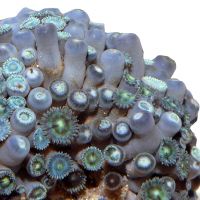Sea Mat (Zoanthus sociatus)
| Sea Mat Zoanthus sociatus | |
|---|---|
| Name | Sea Mat |
| Name Lat. | Zoanthus sociatus |
| Family | Mat Anemones |
| Family lat. | Zoanthidae |
| Order | Zoanthids |
| Order lat. | Zoantharia |
| Origin | Western Atlantic, Caribbean |
| Diet | Autotrophic, planktivore |
| pH | 8.1-8.4 |
| Hardness | 8-10 °KH |
| Lighting | Medium-high |
| Current | Moderate-strong |
| Behavior | Semi-aggressive |
| Keeping | Colony |
| Care Level | Easy |
| Life Span | N/A |
| Protection | No |
| Metric Units | |
| Size | 3-5 cm |
| Temperature | 22-27 °C |
| Salinity | 33-36 ‰ |
| Aquarium | 200 l |
| US Units | |
| Size | 1.2"-2" |
| Temperature | 72-81 °F |
| Salinity | 1.020-1.025 sg |
| Aquarium | 50 gal |
Distribution and habitat
Zoanthus sociatus are widespread in the Caribbean, from Florida to Bermuda to Venezuela. They live in the shallow waters of coastal zones and form large colonies that mat the substrate. Their coloration is highly variable, with the polyp disc being colored differently than their short tentacles.
Maintenance
They should be positioned in the middle or upper area, in a place with medium to high light intensity and moderate, alternating current. A reef structure of live stones that also act as a biological filter will provide the habitat necessary for the animals. Only lime-rich, heavy metal-free substrates may be used as substrate
To ensure water quality, filters, skimmers and heaters are necessary, as well as pumps to simulate tides, swells and bottom currents. Lighting must match the species-appropriate day-night rhythm of the animals
| Salinity: 33-36 ‰ | pH value: 8.1-8.4 |
| Carbonate hardness: 8-10 °KH | Nitrate content: 2-8 mg/l |
| calcium content: 420-450 mg/l | Nitrite content: 0.0-0.05 mg/l |
| Magnesium content: 1.250-1.350 mg/l | phosphate content: 0.01-0.1 mg/l |
Regular addition of trace elements, especially calcium, magnesium, strontium and iodine is recommended. For salinity, an average value should be aimed for, which may only vary slightly by +/- 0.5 ‰. Ammonia and ammonium must not be measurable. Special attention shall be paid to consistently good water quality and water values.
Diet
Zooxanthellae, which are unicellular symbiotic algae, live in their tissue and provide them with assimilation products of their photosynthesis (high light requirement). The zooxanthellae promote growth and provide additional food to the plankton and small particles collected from the water current. In addition, commercially available supplemental food in the form of phyto- and zooplankton should be offered regularly along with the food produced in the aquarium during fish feeding (Artemia, etc.). Regular and varied feeding promotes health and prevents deficiency symptoms.
Behaviour and compatibility
They live in large colonies and can be well socialized with fish that do not consider them food. A sufficient distance to corals must be maintained to avoid encrustation. They are sensitive to algae growth.
Reproduction and breeding
Their asexual reproduction takes place by budding, loose polyp aggregates are carried away with the current and settle elsewhere. Reproduction by fragmentation is quite possible. For this purpose small stones are placed at the edge of the colony and after their overgrowth the junction is separated
Important
Zoanthus owe their coloration to symbiotic algae (zooxanthellae), but it is not the only distinguishing feature for species identification
The additional illumination with actinic light (short-wave, violet-blue light) is very beneficial for their growth (zooxanthellae).
To avoid coming into contact with the venom (palytoxin) of the animals, which can vary in strength, it is recommended to wear gloves when handling them. Due to their venom, they have hardly any natural enemies and quickly colonize vacated areas.
Newly introduced animals must be accustomed slowly to the water in the aquarium. If different species are kept together, care should be taken to ensure that fish and invertebrates match each other in terms of water quality and temperature requirements and social behavior, and that the setup meets the ecological needs of all species kept together
Further literature can be found in your pet store.
References
Text: petdata; Image: petdata
Source: KNOP (2013): Lexikon der Meeresaquaristik, Natur und Tier - Verlag; ENGELMANN & LANGE (2011): Zootierhaltung - Tiere in menschlicher Obhut: Wirbellose, Verlag Harri Deutsch
